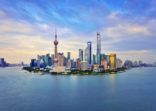“Emerging market equities continue to oscillate because of the ongoing headwinds of the Sino-US trade war, the economic slowdown in China, weakening manufacturing output in many countries and a strong dollar,” Nick Payne, head of global emerging markets at Merian, told a media briefing in Hong Kong yesterday.
However, investors shouldn’t try to trade on the latest macroeconomic news. Instead, they should search for “outstanding companies and aim to pay a reasonable price for them,” said Payne, who manages the $136m Merian Global Emerging Markets Fund.
Besides, although the macro backdrop is bearish, global monetary policy is bullish and China is likely to maintain its targeted stimulus programme, according to Payne.
“Importantly, investor sentiment towards emerging markets as an asset class is pessimistic, which is often – and especially at these levels – a contrarian buy-signal,” he said.
For instance, this is evident in Asia ex-Japan markets, where 6-month forward earnings are below the long-term standard deviation of returns.
Asia ex-Japan: bull/bear signals

Source: Merian Global Investors, Bank of America Merrill Lynch
Other asset and wealth managers have recently turned more positive about emerging markets, such as GAM, which has moved to an overweight position in China because of compelling equity valuations, and UBS Wealth which is positive about China, despite an underweight tilt to global equity markets.
However, Payne is prepared to look at opportunities across the emerging market universe through bottom-up stock selection. He believes that there are two critical factors that determine long-term returns for investors: quality and value.
Top quality companies generate earnings above average returns on invested capital and can maintain returns for longer than the stock market often expects. They also have four characteristics that Warren Buffet identified as building an “economic moat”.
These are: operating in businesses with high barriers to entry, enjoying a cost advantage, possessing strong brands and other intangible assets that allow them to charge a premium for their products, and having a so-called network effect, whereby the value of its service increases as more people use it.
“Long-term value creation is the result of profitability and possession of the ‘moat’, and the compounding of returns over time,” said Payne.
He highlighted four banks stocks in diverse emerging market countries, whose annualised share price return has far exceeded the MSCI Emerging Market index since 2000. These include his favourite lender – Indonesia’s Bank Central Asia (31.6%), Russia’s Sberbank (28.6%), Peru’s Credicorp (22.6%) and India’s HDFC Bank (20.7%).
“These ‘super-compounders’ are exceptional companies,” said Payne.
The price paid for the stock is also crucial, so he buys companies below their intrinsic value, which is determined by analysis of future cashflows, he said.
“Currently, overall valuations [on a price-earnings ratio basis] are below their long-term averages, so now is a decent entry point for investors who can ride out any temporary volatility.”

Source: Merian Global Investors
The fund, which is authorised for sale to accredited investors in Singapore only, is fully invested in a concentrated portfolio of about 35 stocks, with only a small allocation to cash, and its foreign exchange exposure is unhedged, which suggests Payne is ready to put up with a period of volatility and weakness for his fund.
It has generated 15.07% three-year cumulative return in US dollar terms, which is close to the average performance of the sector, but below the return of the MSCI Emerging Markets index. It’s annualised volatility of 15.06% is also higher than both the sector average (12.35%) and the benchmark (14.77%), according to FE Analytics data.
“Significantly, the underlying micro picture for various emerging market countries, sectors and individual companies remains encouraging,” said Payne, who remains committed to his strategy.
“Besides, not all emerging markets are at the same point in the economic cycle, and countries such as Brazil and Indonesia offer compelling opportunities,” he added.
The strategy’s overweight positions also include Peru, India, Malaysia, the Philippines and Mexico. It’s biggest underweight is South Africa, “which suffers from deep-seated problems”, Korea, Saudi Arabia, China, Thailand, Qatar, Poland, Russia and Chile.
“Given slower economic growth and falling interest rates, we advise investors to choose companies that have an ‘economic moat’, strong profitability and a robust earnings growth profile,” said Payne.
These types of companies seem to be most available in the financial, information technology and consumer sectors, where the strategy has large allocations relative to the index.
In contrast, they appear scarce in the energy and materials sectors, which “are cyclical and tend to be price-takers,” according to Payne.
Merian Global Emerging Markets Strategy: allocation profile

Source: Merian Global Investors
Merian Global Emerging Markets Strategy vs MSCI Emerging Markets index and sector average


















